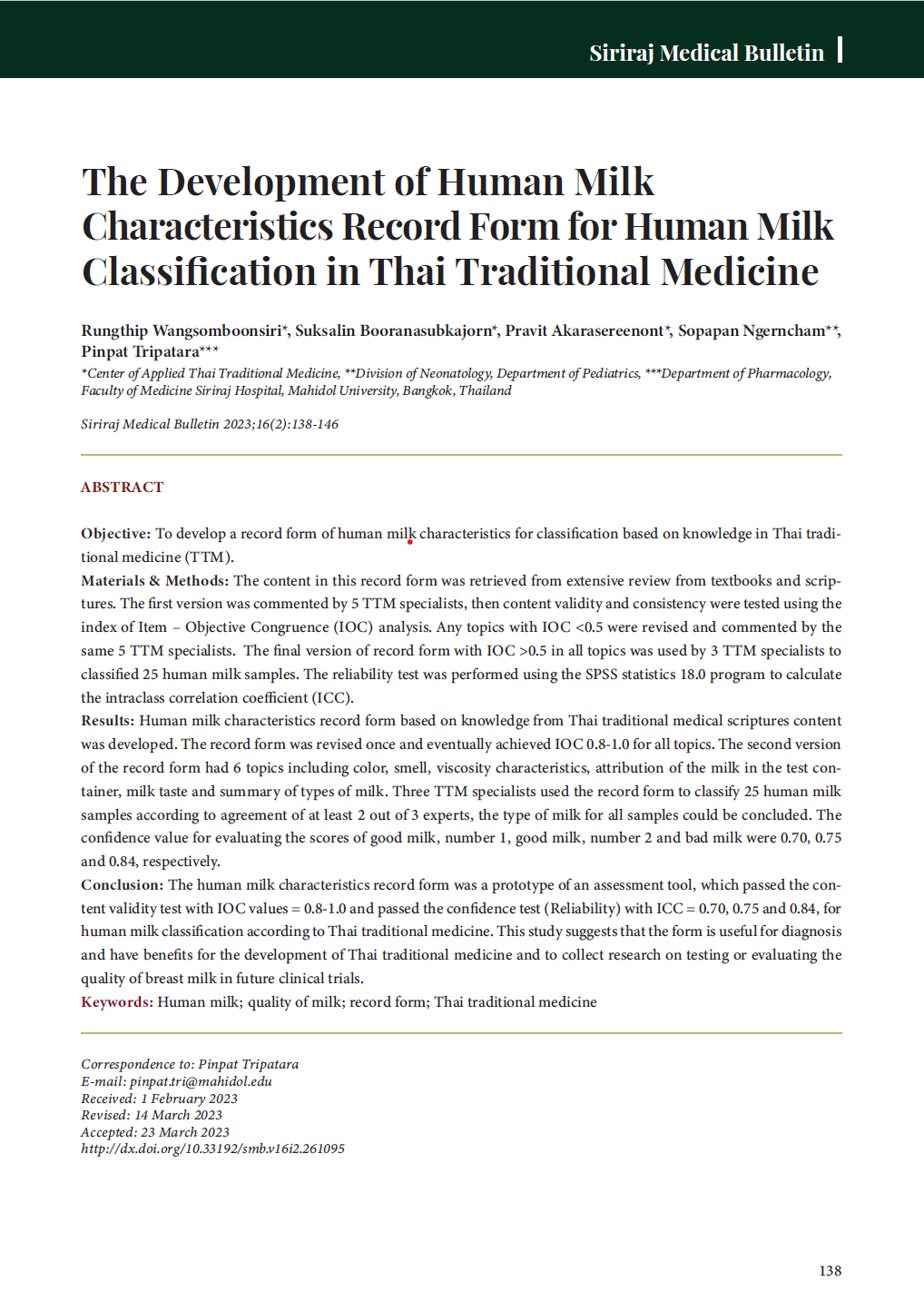The Development of Human Milk Characteristics Record Form for Human Milk Classification in Thai Traditional Medicine
Main Article Content
Abstract
Objective: To develop a record form of human milk characteristics for classification based on knowledge in Thai traditional medicine (TTM).
Materials & Methods: The content in this record form was retrieved from extensive review from textbooks and scriptures. The first version was commented by 5 TTM specialists, then content validity and consistency were tested using the index of item objective congruence (IOC) analysis. Any topics with IOC <0.5 were revised and commented by the same 5 TTM specialists. The final version of record form with IOC >0.5 in all topics was used by 3 TTM specialists to classified 25 human milk samples. The reliability test was performed using the SPSS statistics 18.0 program to calculate the intraclass correlation coefficient (ICC).
Results: Human milk characteristics record form based on knowledge from Thai traditional medical scriptures content was developed. The record form was revised once and eventually achieved IOC 0.8-1.0 for all topics. The second version of the record form had 6 topics including color, smell, viscosity characteristics, attribution of the milk in the test container, milk taste and summary of types of milk. Three TTM specialists used the record form to classify 25 human milk samples according to agreement of at least 2 out of 3 experts, the type of milk for all samples could be concluded. The confidence value for evaluating the scores of good milk, number 1, good milk, number 2 and bad milk were 0.70, 0.75 and 0.84, respectively.
Conclusion: The human milk characteristics record form was a prototype of an assessment tool, which passed the content validity test with IOC values = 0.8-1.0 and passed the confidence test (Reliability) with ICC = 0.70, 0.75 and 0.84, for human milk classification according to Thai traditional medicine. This study suggests that the form is useful for diagnosis and have benefits for the development of Thai traditional medicine and to collect research on testing or evaluating the quality of breast milk in future clinical trials.
Article Details

This work is licensed under a Creative Commons Attribution-NonCommercial-NoDerivatives 4.0 International License.
References
สถานการแพทย์แผนไทยประยุกต์ คณะแพทยศาสตร์ศิริราชพยาบาล มหาวิทยาลัยมหิดล. การแพทย์แผนไทยประยุกต์กับการพัฒนาการแพทย์แผนไทยให้ยั่งยืน 2555. กรุงเทพฯ: ศุภวนิชการพิมพ์; 2555.
มูลนิธิฟื้นฟูส่งเสริมการแพทย์ไทยเดิม. ตำราการแพทย์ไทยเดิม (แพทยศาสตร์สงเคราะห์ ฉบับอนุรักษ์) เล่มที่ ๑ ฉบับชำระ พ.ศ. ๒๕๕๐. กรุงเทพฯ: ศุภวนิชการพิมพ์; 1992.
Van Sadelhoff JH, Mastorakou D, Weenen H, Stahl B, Garssen J, Hartog A. Differences in levels of free amino acids and total protein in human foremilk and hindmilk. Nutrients. 2018;10(12):1828.
Wu K, Zhu J, Zhou L, Shen L, Mao Y, Zhao Y, et al. Lactational changes of fatty acids and fat-soluble antioxidants in human milk from healthy Chinese mothers. Br J Nutr. 2020;123(8):841-8.
สุธาทิพย์ มหาเจริญสิริ. การพัฒนาแบบประเมินเพื่อการวินิจฉัยธาตุเจ้าเรือนปกติลักษณะ ทางการแพทย์แผนไทย. Siriraj Med J. 2017;10(2):65-73.
Davis AE. Instrument development: getting started. J Neurosci Nurs. 1996;28(3):204-8.
Rovinelli RJ, Hambleton RK. On the use of content specialists in the assessment of criterion-referenced test item validity. Laboratory of Psychometric and Evaluative Research Report No.24. Proceedings of the 60th Annual Meeting of the American Educational Research Association; 1976 Apr 19-23; San Francisco, California. Massachusetts: The University of Massachusetts; 1976.
Koo TK, Li MY. A guideline of selecting and reporting intraclass correlation coefficients for reliability research. J Chiropr Med. 2016;15(2):155-63.






